It’s been nearly two years since UNMC’s Department of Otolaryngology-Head and Neck Surgery opened its state-of-the-art bone lab, and the results have been superlative, allowing otolaryngology and neurosurgery residents to hone their skills in a facility that compares favorably with any other in the country.
Dwight Jones, M.D., chairman of the department, said that since the bone lab opened, there have been a number of regular courses, drawing regional and national attention.
Every year since the bone lab opened, courses have been offered in basic temporal bone anatomy; advanced surgery of baseof- skull for neurosurgeons; endoscopic sinus; and microvascular flap, in which residents are taught to sew microscopic blood vessels together, he said.
“The microvascular flap course now is a national course,” Dr. Jones said.
When the bone lab opened in Poynter Hall in May 2013, Dr. Jones was excitedfor the possibilities, but the lab has proved even more popular than he expected.
“I did not foresee that the bone lab would be this versatile,” he said.
“Neurosurgeons use it weekly, but it never dawned on me the kinds of things we could do in this lab. After the lab opened, then we realized the flexibility and opportunity it provided.”
The lab offers roughly three times the space of its earlier counterpart, with 10 microscope stations (up from two) and video screens that allow faculty to interact with residents in real time. In addition, the video screens allow the instructors to monitor up to four or five residents at a time.
Students were ecstatic when it opened.
Asked to compare the new space to the old one, resident Jessica Moran- Hansen, M.D., called it “100 times better.
“There is no comparison to this and other national laboratories that we’ve visited,” she said. Reactions like this have helped the lab recruit top medical students and residents to UNMC, Dr. Jones said.
“Ours is one of the top bone labs for ENT/neurosurgery in the country,” he said.
In addition to the annual courses, the lab now hosts a biannual regional temporal bone program that draws students from Kansas, Missouri, Arkansas and Oklahoma as well as Nebraska. Oral surgeons use
the lab annually for a mandibular and facial fracture plating course.
Dr. Jones expects to see more national courses in the future. There is a national endoscopic sinus surgery course coming up, and there will be national temporal bone courses as well.
“I’d like to have at least one – local or national – course going on in the lab every month,” he said.
Raising funds for the lab was a process that took more than two years, but it’s proved worth it, Dr. Jones said.
“This is the type of investment in technology and infrastructure that has really helped boost our program to higher national recognition,” he said. “Since it opened, we’ve had more resident applicants per year than the department has ever had.”
